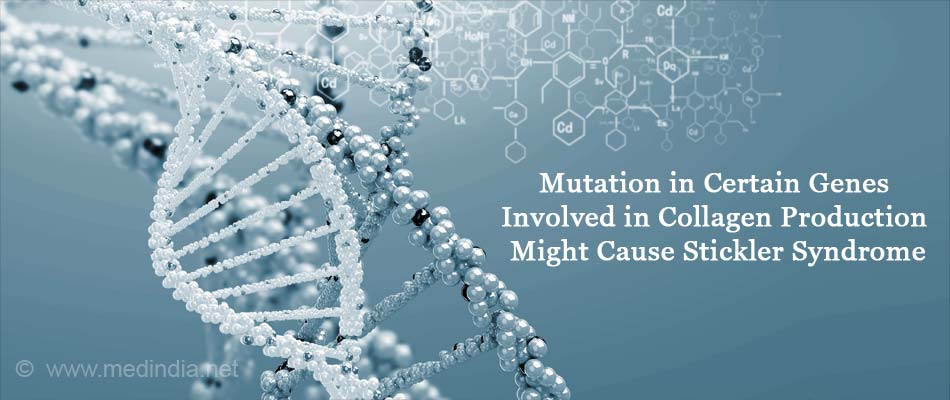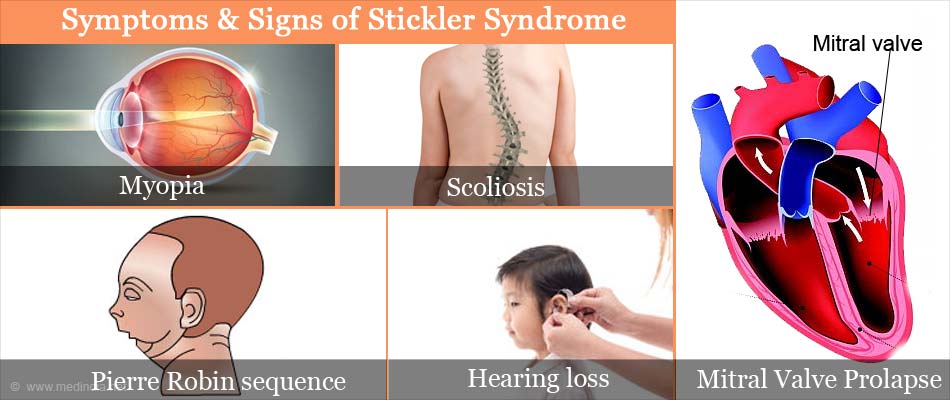- Rare Disease - Stickler Syndrome - (https://rarediseases.org/rare-diseases/stickler-syndrome/)
- Stickler Syndrome - (https://www.marfan.org/resource/fact-sheet/stickler-syndrome#.wtibz9r95kg)
- Stickler Syndrome in Children - (http://www.childrenshospital.org/conditions-and-treatments/conditions/s/stickler-syndrome/overview)
What is Stickler Syndrome?
Stickler Syndrome is a genetic disease that affects the connective tissue of the body and presents as a multi-system disorder. Connective tissue is the tissue that connects and supports body structures. It usually consists of collagen.
Individuals with Stickler Syndrome suffer from vision problems, loose joints, osteoarthritis, cleft palate, hearing loss and heart valve defects.
The prevalence of Stickler Syndrome is around 1 in 7500 but in many cases, the syndrome remains undiagnosed or misdiagnosed.
What are the Causes of Stickler Syndrome?
Stickler Syndrome is a genetic condition caused by a mutation in the gene which is responsible for production of collagen, thereby resulting in abnormal collagen formation. Since collagen is a constituent of several organs, the disease affects multiple organs of the body.

Stickler Syndrome is divided into five types – referred to as Stickler Syndrome I to V - depending on the location of the mutation and the inheritance pattern.
Stickler Syndrome is usually inherited in an autosomal dominant pattern, wherein even one abnormal copy of the gene is sufficient for the expression of the disease. The disease transmission does not depend on the sex of the child; that is, the disease has an equal chance of being passed on to the child irrespective of whether the child is male or female. The few cases of type IV, and the possible one case of type V may be inherited in an autosomal recessive pattern, where two abnormal genes are necessary for the disease to manifest.
What are the Signs and Symptoms of Stickler Syndrome?
The symptoms and signs of Stickler Syndrome can be present at birth, or in many cases, appear after birth. Stickler Syndrome is a progressive disorder, hence the symptoms affecting multiple systems appear as the child ages. The organs most commonly affected are the eyes, joints, face, ears, and heart. The organs are involved to a varying degree among affected individuals.
Eyes:
Patients with Stickler Syndrome may present with the following eye problems:
- Myopia or short sightedness
- Vitreoretinal degeneration, which affects the vitreous humor and the retina of the eye. The vitreous is a jelly-like fluid which fills the ball of the eye behind the iris and helps to maintain the shape of the eyeball. Vitreous abnormalities present as floaters, wherein the child sees small floating objects in front of his/her eyes. These floaters affect the child’s vision. The retina is the light-sensitive inner layer of the eye. It contains receptors which are responsible for our visual sense. In Stickler Syndrome, the retina gets detached causing sudden loss of vision
- Vision problems due to lens abnormalities. These may be due to an opacification of the lens resulting in cataract, or due to a change in the curvature of the lens
- Cross eyes, where the eyes do not move in synchrony
- Abnormalities in the curvature of the cornea, the transparent disc through which light enters the eye, resulting in vision problems
- Rarely, glaucoma, which refers to an increase in pressure within the eyeball
Joints:
Children affected with Stickler Syndrome have hyper-extensible loose joints which result in repeated joint dislocation. In the second and third decades of life, the joints turn stiff due to repeated wear and tear. Arthritis of the joints sets in making the movement of joints difficult and painful. The spine also shows abnormalities like scoliosis (excessive sideways curvature) and kyphosis (excessive forward curvature in upper back). Children complain of repeated back pain due to misalignment of the spine. Depression or prominence of the chest bone may be present.
Face:
Children with Stickler Syndrome present with characteristic facial features like flat cheekbones, flat nose, long upper lip and small chin. Some children also show some characteristic features called Pierre Robin sequence, which include micrognathia (small jaw), glossoptosis (retraction of the tongue) and cleft palate or uvula (incomplete closure of the roof of the mouth). These changes cause difficulty in feeding and breathing.
Ears:
Stickler Syndrome causes two types of hearing loss. In some cases, there is a failure in the conduction of sound (due to a problem in the middle ear) while in others, the auditory nerve is damaged, resulting in sensorineural hearing loss. A combination of conductive and sensorineural hearing loss may also occur. Frequent infection of the middle ear is also a feature of Stickler Syndrome.
Heart:
Some children can present with breathlessness or excessive fatigue. This is due to prolapse of a valve in the heart called the mitral valve. The mitral valve is the valve between the two left chambers of the heart. Due to the prolapse, blood regurgitates from the left ventricle to the left atrium resulting in inefficient pumping of the blood to the body.

What are the Complications of Stickler Syndrome?
Depending on the organ system affected, Stickler Syndrome can cause various complications like blindness, deafness, arthritis or heart failure. Since Stickler Syndrome is a progressive degenerative disorder, it is essential to monitor symptoms closely and treat them promptly to avoid life-threatening complications.
How do you Diagnose Stickler Syndrome?
The diagnosis of Stickler Syndrome relies on fair clinical suspicion and can be missed in cases where the various symptoms are not correlated. The diagnosis is primarily clinical and is confirmed by x-ray of joints and ophthalmoscopy (examination of the eye). A genetic test helps to detect the presence of the mutation. A 12-point system of characteristic features is used for diagnosis of Stickler Syndrome. A minimum of 5 points with one or more major manifestation must be present to arrive at a diagnosis, along with the absence of features suggestive of any other syndrome.
How do you treat Stickler Syndrome?
There is no cure for Stickler Syndrome. The management is based upon treating the symptoms in the patient. For example, glasses may be required for vision problems or laser for retinal detachment. Surgery might be required to treat facial and heart or bony abnormalities. Hearing aids may be required in patients with hearing loss. The treatment of the child requires close multidisciplinary surveillance by a team of experts like a pediatrician, ophthalmologist, otorhinolaryngologist, and an orthopedician.
What is the Prognosis of Stickler Syndrome?
Stickler Syndrome does not affect the life expectancy of an individual. Once diagnosed, the doctor and the patient's parents can take proactive steps to monitor any abnormality and promptly correct it. Awareness of the disorder and its complications remains the key to a healthy life in these patients.
Health Tips
- Stickler Syndrome has symptoms which need to be treated. Knowledge of the syndrome helps the affected individual and his/her family keep a close watch on the possible symptoms.
- Regular health check-ups are required for early diagnosis and prompt treatment.
- Genetic counseling is necessary to understand how the mutation can pass on to the offspring









